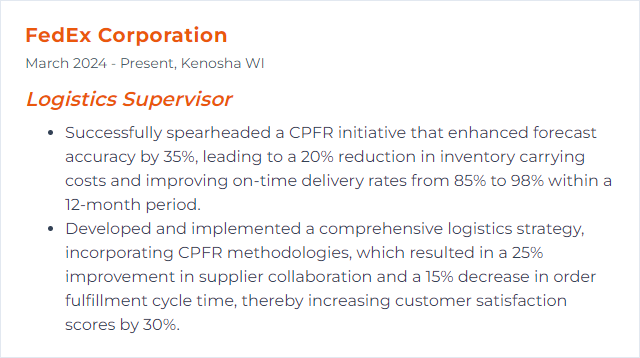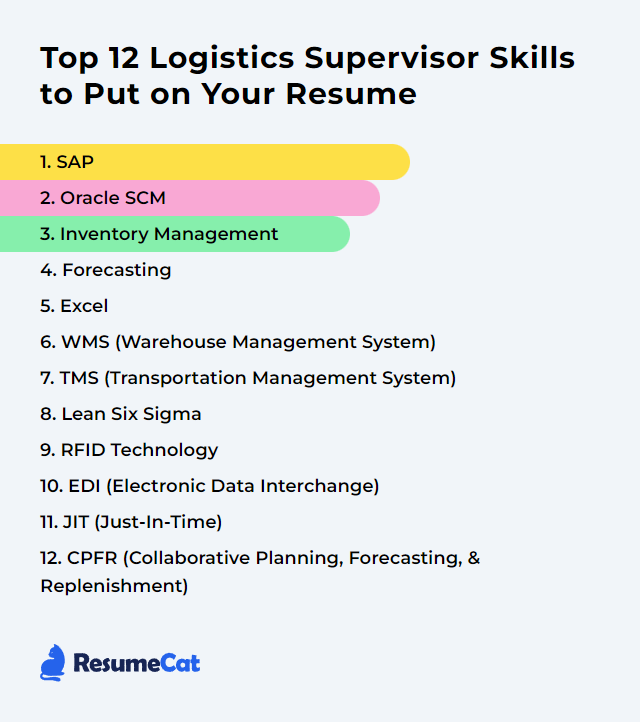Top 12 Logistics Supervisor Skills to Put on Your Resume
In today's fast-moving, often messy supply chain world, a Logistics Supervisor’s resume has to punch through the noise. Blend hard systems know-how with people-savvy execution. Show fluency in tools, prove you can steer operations when plans wobble, and make that efficiency story unmistakable.
Logistics Supervisor Skills
- SAP
- Oracle SCM
- Inventory Management
- Forecasting
- Excel
- WMS (Warehouse Management System)
- TMS (Transportation Management System)
- Lean Six Sigma
- RFID Technology
- EDI (Electronic Data Interchange)
- JIT (Just-In-Time)
- CPFR (Collaborative Planning, Forecasting, and Replenishment)
1. SAP
SAP is an ERP backbone that ties finance, procurement, inventory, production, and logistics into one living system. In practice: you get real-time visibility, tighter controls, and smoother handoffs across the supply chain.
Why It's Important
For a Logistics Supervisor, SAP anchors inventory accuracy, inbound/outbound flow, and order promise dates. Less guesswork. Faster decisions. Fewer surprises.
How to Improve SAP Skills
Focus on what moves the needle in 2025: S/4HANA and modern planning.
Shift from legacy to modern: Prioritize S/4HANA capabilities, Embedded EWM for warehouse workflows, and PP/DS for short-term planning. Retire old APO habits in favor of SAP IBP for demand and supply planning.
Tighten master data: Clean material masters, units, and storage views. Bad data breaks good processes.
Automate the routine: Use SAP Fiori apps and SAP Build Process Automation to cut clicks, auto-post status updates, and reduce manual touches.
Integrate deliberately: Connect SAP to WMS/TMS/CRM via Integration Suite or APIs so orders, ASN events, and tracking flow in real time.
Measure what matters: Stand up KPI dashboards (fill rate, OTIF, inventory turns, dock-to-stock) with SAP Analytics Cloud or BusinessObjects and act on them weekly.
Train in the flow: Role-based playbooks for S/4HANA and EWM tasks. Short, scenario-driven sessions beat big-bang training.
How to Display SAP Skills on Your Resume
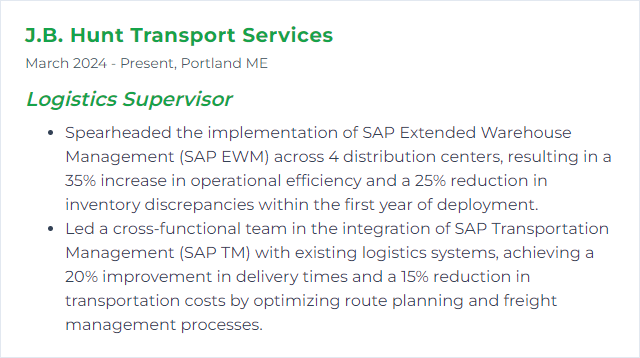
2. Oracle SCM
Oracle Fusion Cloud SCM is a suite for planning, sourcing, product, warehouse, transportation, and order orchestration—built for real-time visibility and rapid change.
Why It's Important
It helps a Logistics Supervisor compress lead times, control cost-to-serve, and keep promises to customers through unified data and coordinated execution.
How to Improve Oracle SCM Skills
Use embedded analytics: Track service levels, carrier performance, and inventory health. Turn exceptions into alerts, not hindsight.
Connect the stack: Integrate ERP, WMS, TMS, and planning so orders, forecasts, and shipment events are synced. Fewer reconciliations, faster escalations.
Exploit automation: Auto-rate shop, auto-tender, and auto-allocate inventory by rules. Keep humans for edge cases.
Tune configurations: Tailor allocation, picking, and routing strategies to your network—seasonality and regional realities included.
Upskill the team: Short sprints on new features and process changes keep adoption high and workarounds low.
Review KPIs often: Monthly design reviews on cost per order, OTIF, and dock utilization. Adjust settings, not just behaviors.
How to Display Oracle SCM Skills on Your Resume
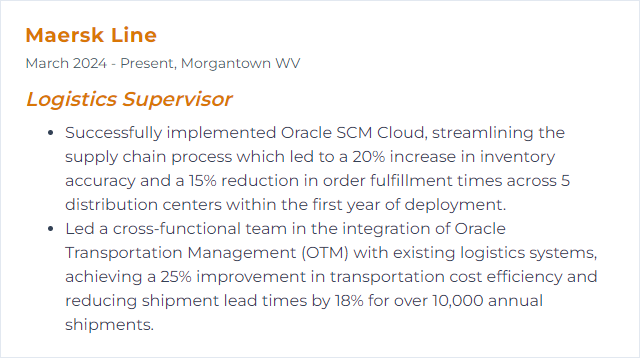
3. Inventory Management
Inventory management means striking the balance between too much and too little. Order, store, count, and move stock so what’s needed is ready—without money gathering dust on shelves.
Why It's Important
It protects cash, customer promise dates, and warehouse sanity. Nail accuracy and flow, and everything else gets easier.
How to Improve Inventory Management Skills
Real-time visibility: Use system-driven receipts, moves, and issues. No shadow spreadsheets for stock truths.
Right-size policies: Set min/max, safety stock, and reorder points by ABC class and variability, not hunches.
Cycle counting that works: Frequent counts for A items, fewer for C items. Measure count accuracy and fix root causes.
Forecast with feedback: Blend history with promotions, seasonality, and market signals. Review forecast error (MAPE/WAPE) and refine.
Tidy the warehouse: Slot fast movers close, reduce touches, streamline putaway and pick paths.
Supplier cadence: Lock in lead times, packaging, and ASN data quality. Reliability beats speed when planning.
Train and standardize: Clear SOPs for receipts, moves, and adjustments. One way of working, not five.
How to Display Inventory Management Skills on Your Resume
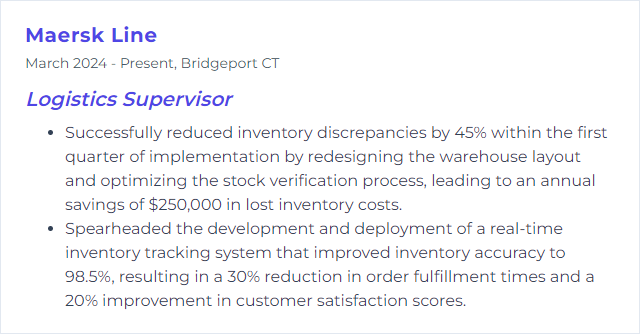
4. Forecasting
Forecasting anticipates demand, capacity needs, and inventory posture so logistics can staff, slot, and ship without drama.
Why It's Important
Better forecasts mean fewer expedites, steadier labor plans, and smarter stock levels. Costs fall. Service rises.
How to Improve Forecasting Skills
Use multiple lenses: Baseline history, layer seasonality and promotions, and sanity-check with sales and ops. One model rarely wins alone.
Go probabilistic: Plan to ranges and confidence intervals. Size buffers to variability, not averages.
Measure error: Track MAPE, bias, and forecast-value-add by item and location. Keep what helps, drop what doesn’t.
Refresh often: Shorten the update cycle for volatile items. Weekly beats monthly when demand whipsaws.
Scenario planning: Build what-if cases for supplier delays, demand spikes, or transport constraints. Pre-bake responses.
Close the loop: Compare forecast to actuals, capture causes, and tweak parameters. Continuous tuning, not set-and-forget.
How to Display Forecasting Skills on Your Resume
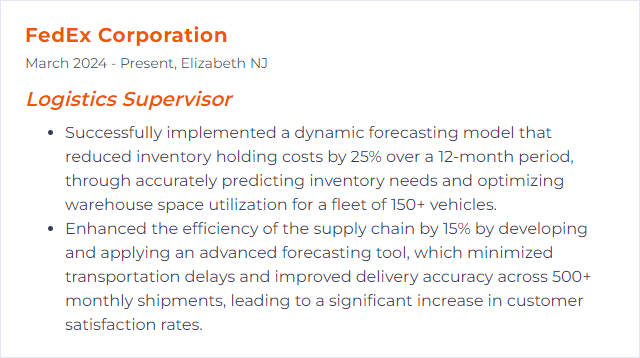
5. Excel
Excel is the Swiss Army knife for logistics data—quick analyses, ad hoc reporting, and lightweight planning when systems lag behind needs.
Why It's Important
Fast pivots, clean visuals, and clear calculations help you detect exceptions, justify decisions, and keep teams aligned.
How to Improve Excel Skills
Modern functions: Favor XLOOKUP over VLOOKUP, and lean on FILTER, UNIQUE, and SORT to tame datasets.
Dynamic arrays: Build formulas that spill and scale, not copy-paste monsters.
Power Query: Automate data imports, cleaning, and merges. One refresh, many sources.
Power Pivot: Model large datasets, relate tables, and write simple DAX for robust metrics.
Pivot mastery: Fast summarization with slicers and timelines for interactive reviews.
Light automation: Record macros for repetitive steps; use Office Scripts where available for cloud-native tasks.
Tell the story: Clear charts, consistent labels, and a stark focus on the decision at hand.
How to Display Excel Skills on Your Resume

6. WMS (Warehouse Management System)
A WMS directs receipts, putaway, picking, packing, and shipping—turning chaos into choreography inside the four walls.
Why It's Important
It cuts touches, raises accuracy, and keeps orders flowing. That means lower cost per line and happier customers.
How to Improve WMS (Warehouse Management System) Skills
Map the process: From dock to dock, document reality. Then remove detours and double handling.
Slotting that pays: Place fast movers close, group affinities, and revisit seasonally. Your feet will thank you.
Leverage tech: Barcodes and RFID where they fit; voice or wearable picking for speed; scales and dimensioners for accuracy.
Smarter waves: Use wave or waveless strategies based on order mix. Batch, zone, or cluster pick to reduce travel.
Cycle count culture: Event-driven counts after exceptions; daily micro-counts to keep truth fresh.
Labor management: Track engineered standards, remove friction, and balance workload across shifts.
Keep it current: Apply updates, test in a sandbox, and train before go-live. No cowboy changes.
How to Display WMS (Warehouse Management System) Skills on Your Resume
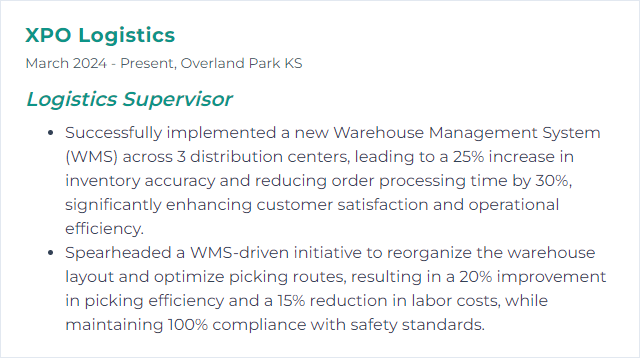
7. TMS (Transportation Management System)
A TMS plans routes, selects carriers, tenders loads, tracks shipments, and reconciles freight—end to end.
Why It's Important
You get lower freight spend, stronger on-time performance, and real-time status when things veer off course.
How to Improve TMS (Transportation Management System) Skills
Integrate widely: Connect with ERP/WMS, carriers, and visibility platforms so tenders, tracking, and invoices flow without rekeying.
Let data steer: Monitor cost per mile, tender acceptance, dwell, and OTD. Use alerts for exceptions, not inbox floods.
Carrier strategy: Curate a balanced mix—primary, backup, and niche carriers. Scorecards keep the bar high.
Exploit optimization: Consolidate shipments, milk-run where logical, and tune constraints regularly.
Digitize documents: Electronic BOLs, proofs of delivery, and invoice audit rules reduce leakage and delay.
Green levers: Favor fuller trucks, smarter routing, and emissions tracking. Savings often follow sustainability.
Coach the team: Short refreshers when features change keep adoption sticky and errors rare.
How to Display TMS (Transportation Management System) Skills on Your Resume

8. Lean Six Sigma
Lean trims waste; Six Sigma crushes variation. Together they make processes flow smooth, repeatable, and cheaper.
Why It's Important
Fewer defects, faster cycles, and clearer standards. Logistics benefits directly—less rework, fewer expedites, and cleaner inventories.
How to Improve Lean Six Sigma Skills
DMAIC with teeth: Define the problem crisply, measure with trustworthy data, analyze root causes, improve once, and lock gains with control plans.
Gemba first: Go see the work—docks, pack stations, yards. Reality beats reports.
Visual management: Boards, andons, and simple KPIs where work happens. Problems should glow red, not hide.
Rapid kaizen: Short, focused events that change layouts, eliminate touches, and simplify SOPs.
Stat tools that matter: Pareto, fishbone, SPC charts. Use just enough analytics to decide and move.
Cross-functional crews: Include IT, warehouse, transportation, and customer service. Silos breed blind spots.
How to Display Lean Six Sigma Skills on Your Resume
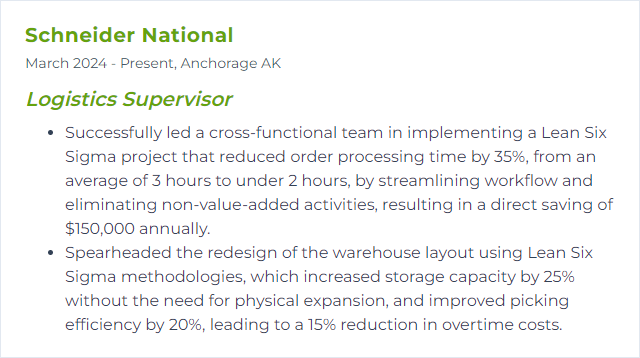
9. RFID Technology
RFID uses radio waves to identify and track tagged items without direct line of sight—lightning-fast scans, richer data.
Why It's Important
It boosts inventory accuracy, speeds counts, and provides near-real-time location signals for assets and goods.
How to Improve RFID Technology Skills
Engineer the environment: Test reader placement, antenna orientation, and power to handle metal, liquids, and interference.
Choose the right tags: UHF for range, rugged tags for harsh zones, dual tagging for tricky items.
Filter the noise: Apply middleware rules to reduce stray reads and de-duplicate events.
Secure the pipeline: Encrypt where appropriate, segment networks, and monitor for odd traffic.
Integrate events: Feed WMS/TMS with read events so status, counts, and exceptions update automatically.
Maintain and calibrate: Keep firmware current, audit read rates, and rotate batteries on active tags before they die on you.
How to Display RFID Technology Skills on Your Resume
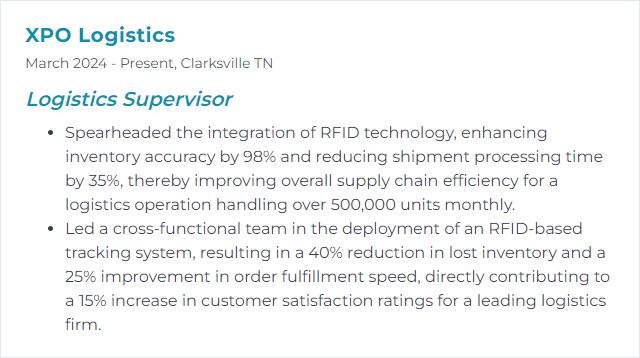
10. EDI (Electronic Data Interchange)
EDI is the structured exchange of documents (purchase orders, ASNs, invoices) between partners—system to system.
Why It's Important
It reduces manual entry, cuts errors, and accelerates order-to-cash. Logistics runs cleaner when signals are timely and standard.
How to Improve EDI (Electronic Data Interchange) Skills
Standardize deliberately: Use agreed transaction sets (e.g., 850, 856, 810) and lock versioning. Drift invites chaos.
Harden transports: Prefer secure channels (AS2, SFTP) with retries and acknowledgments baked in.
Validate early: Schema checks, business rule validation, and partner-specific edits before data hits core systems.
Monitor everything: Dashboards and alerts for failed transmissions, delayed 997s, or missing ASNs.
Integrate tightly: Seamless handoffs to ERP/WMS/TMS so status changes and inventory moves are instant.
Onboard with discipline: Clear test cases, sample files, and a go-live checklist for each trading partner.
How to Display EDI (Electronic Data Interchange) Skills on Your Resume
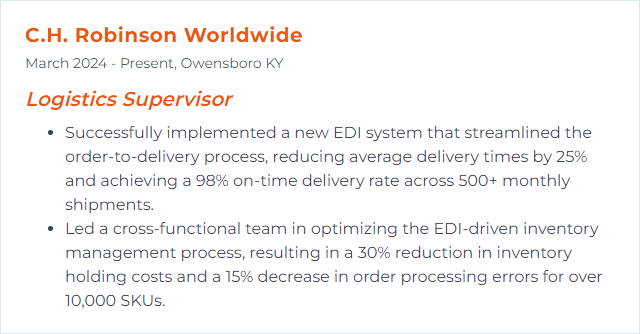
11. JIT (Just-In-Time)
JIT keeps inventory lean by receiving goods right when they’re needed. Less carrying cost, more flow—if the chain holds.
Why It's Important
It trims waste and space while sharpening responsiveness. When demand and supply wobble, disciplined JIT prevents bloat.
How to Improve JIT (Just-In-Time) Skills
Supplier reliability: Lock clear SLAs, share short-term forecasts, and build trust through consistent cadence.
Risk buffers: Add small, targeted safety stocks for volatile parts and near-shore alternates for critical items.
Lean the flow: Remove non-value steps, shrink changeovers, and stabilize takt. Shorter cycles make JIT viable.
Visibility matters: Real-time PO, ASN, and transit status. No surprises at the dock.
Postponement: Keep semi-finished goods and finalize late to handle mix without ballooning stock.
Continuous tune-ups: Review misses, fix root causes, and adjust reorder signals promptly.
How to Display JIT (Just-In-Time) Skills on Your Resume
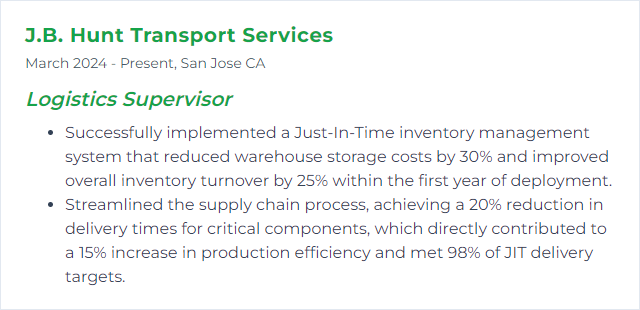
12. CPFR (Collaborative Planning, Forecasting, and Replenishment)
CPFR aligns retailers, suppliers, and sometimes carriers on a single plan for demand, supply, and inventory so the chain moves as one.
Why It's Important
Shared truths beat siloed guesses. You get steadier service levels, lower safety stocks, and fewer firefights.
How to Improve CPFR (Collaborative Planning, Forecasting, and Replenishment) Skills
One plan, one calendar: Agree on cycles for forecast updates, replenishment, and promotions. Rhythm drives reliability.
Data quality first: Clean product hierarchies, locations, lead times, and event flags. Garbage in, arguments out.
Transparent metrics: Publish service, forecast error, and inventory turns to all parties. Shared scorecards, shared accountability.
Exception management: Focus meetings on deltas—big movers, low stock risk, constrained lanes.
Connect systems: API or file-based exchanges that are automated, logged, and auditable. No email gymnastics.
Train the partnership: Common definitions, clear roles, and a playbook for escalations keep collaboration from stalling.
How to Display CPFR (Collaborative Planning, Forecasting, and Replenishment) Skills on Your Resume
